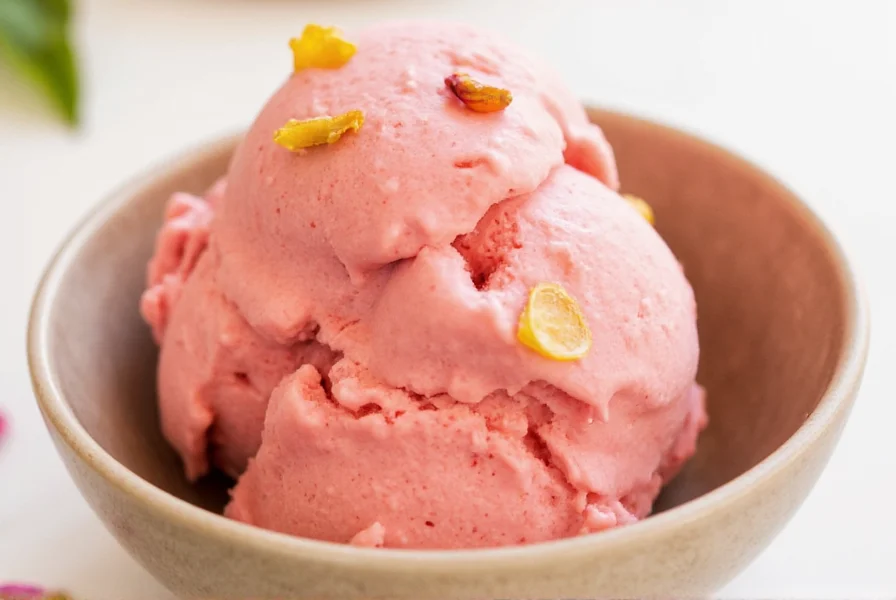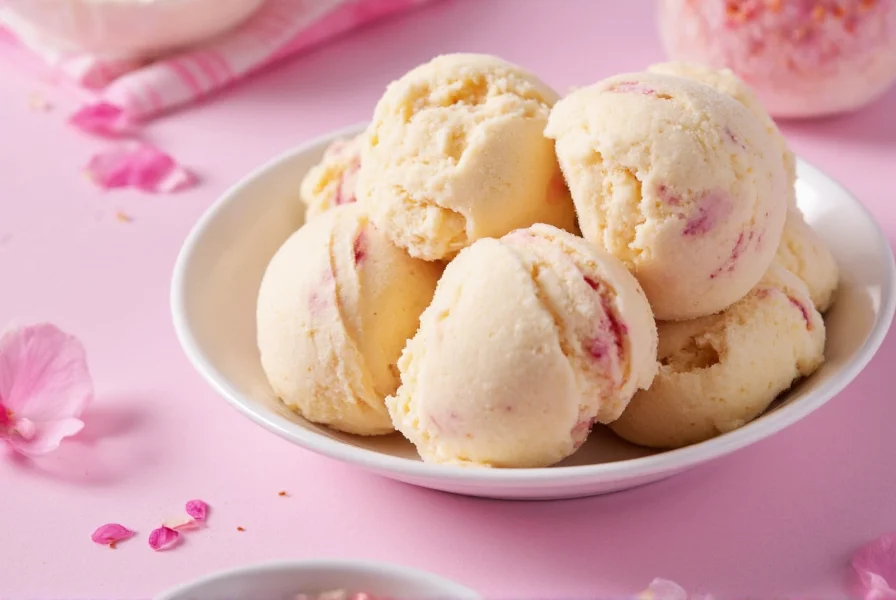Saffron and rose ice cream, celebrated as bastani sonnati in its Persian homeland, represents one of the world's most sophisticated frozen desserts. This distinctive treat combines two precious ingredients—saffron, the world's most expensive spice, and rose water, a fragrant floral distillate—to create a sensory experience that has delighted palates for centuries across Iran, India, and neighboring regions.
The Cultural Heritage of Saffron and Rose Ice Cream
Originating in ancient Persia, this ice cream variant emerged from Iran's sophisticated culinary traditions where ice was harvested from mountain peaks and stored in yakhchāls (ancient refrigeration structures). Historical records indicate that Persian royalty enjoyed early versions of bastani as early as the 5th century BCE, with saffron valued for both its color and perceived medicinal properties.
The dessert gained particular prominence during the Safavid dynasty (1501-1736), when Persian cuisine reached new heights of refinement. Traditional bastani sonnati was originally made without modern ice cream makers, using a labor-intensive process of packing ice and salt around metal containers to achieve freezing temperatures—a technique that required significant skill and patience.
Understanding the Flavor Profile
The magic of authentic saffron and rose ice cream lies in the precise balance between its two signature ingredients:
| Ingredient | Flavor Contribution | Visual Impact | Traditional Measurement |
|---|---|---|---|
| Saffron | Earthy, honey-like notes with subtle bitterness | Vibrant golden-yellow color | 15-20 threads per quart |
| Rose Water | Floral, perfumed aroma with citrus undertones | Clear appearance (no color change) | 1-2 teaspoons per quart |
Quality saffron should produce a rich golden hue without artificial coloring, while rose water must be food-grade and specifically formulated for culinary use—perfume-grade rose water contains chemicals unsafe for consumption. The ideal ratio creates a harmonious blend where neither flavor dominates, resulting in what Persian connoisseurs describe as "golab-e mohrab" (rose of the warrior)—strong yet delicate.
Traditional Preparation Methods
Authentic bastani sonnati differs significantly from Western ice cream through its ingredient selection and preparation techniques:
- Dairy base: Traditional recipes use a combination of heavy cream, whole milk, and sometimes clotted cream (qeymeh) for exceptional richness
- Saffron preparation: Threads are steeped in warm milk or water for 20-30 minutes to fully release color and flavor compounds
- Rose water addition: Added at the very end of preparation to preserve volatile aromatic compounds
- Texture: Traditional versions often have a denser, less aerated texture than commercial ice creams
Many Persian households still prepare bastani using the setareh method—layering ice and salt around a metal container placed inside a wooden bucket, then manually churning the mixture until it reaches the proper consistency. This labor-intensive process creates a uniquely smooth texture that modern ice cream makers often struggle to replicate.
Creating Authentic Saffron and Rose Ice Cream at Home
While traditional preparation requires specialized equipment, you can create an authentic-tasting version with standard kitchen tools. This recipe yields 1 quart of bastani sonnati:
Ingredients for authentic Persian saffron ice cream
- 2 cups heavy cream
- 1 cup whole milk
- 3/4 cup granulated sugar
- 20 high-quality saffron threads
- 2 tablespoons rose water (culinary grade)
- 1/4 teaspoon cardamom (optional)
- 2 tablespoons finely chopped pistachios
Step-by-step preparation
- Grind saffron threads with 1 teaspoon of sugar to break them down
- Steep saffron in 2 tablespoons warm milk for 30 minutes
- Whisk cream, remaining milk, sugar, and cardamom until sugar dissolves
- Combine with saffron mixture and rose water
- Cover and chill mixture for at least 4 hours (preferably overnight)
- Churn in ice cream maker according to manufacturer's instructions
- Fold in pistachios during last 2 minutes of churning
- Transfer to container, press parchment paper on surface, and freeze until firm
For optimal flavor development, allow the ice cream to mature in the freezer for 24 hours before serving. This resting period lets the saffron and rose flavors fully integrate and mellow.
Serving Traditions and Pairings
In Iran, bastani sonnati is traditionally served in distinctive ways that enhance the experience:
- With nan-nan: Thin, crisp Persian wafers that provide textural contrast
- Garnished generously: With crushed pistachios and sometimes slivered almonds
- Accompanied by tea: Strong Persian black tea served in small glasses
- Seasonal presentation: Often served during Ramadan and special celebrations
Modern interpretations include serving bastani with fresh fruit compotes, as a topping for warm Persian rice pudding (sholeh zard), or even incorporated into milkshakes for a contemporary twist while maintaining traditional flavor profiles.
Common Challenges and Solutions
Creating perfect saffron and rose ice cream requires attention to several potential pitfalls:
- Overpowering rose flavor: Use only culinary-grade rose water and start with 1 teaspoon—additional amounts can be added incrementally
- Weak saffron color: Ensure saffron is fresh (less than 6 months old) and properly steeped in warm liquid
- Crystallization: Maintain proper sugar-to-liquid ratio (minimum 20% sugar content) to prevent ice crystals
- Flavor imbalance: Taste mixture before churning and adjust saffron or rose water as needed

Regional Variations Across Cultures
While Persian bastani sonnati remains the original version, neighboring cultures have developed distinctive interpretations:
- Indian kulfi: Denser, less aerated version often including reduced milk solids (khoya)
- Turkish variants: May include mastic gum for distinctive texture and flavor
- Arabic interpretations: Sometimes incorporate orange blossom water alongside rose water
- Modern fusion: Chefs in Western countries often add complementary flavors like pistachio or cardamom
Each variation maintains the essential saffron-rose combination while adapting to local tastes and available ingredients—a testament to the enduring appeal of this sophisticated flavor pairing.
Frequently Asked Questions
What's the difference between bastani sonnati and regular ice cream?
Bastani sonnati differs from Western ice cream through its distinctive saffron and rose water flavoring, denser texture with less air incorporation, and traditional preparation methods. Authentic Persian bastani uses higher fat content from cream and sometimes clotted cream, creating a richer mouthfeel. The precise balance of saffron's earthy notes with rose water's floral aroma defines its unique character, often served with pistachios and nan-nan wafers rather than typical Western toppings.
How can I tell if I'm getting authentic saffron for ice cream?
Authentic saffron for ice cream should have deep red threads with minimal yellow style (the less yellow, the higher quality). When steeped in warm liquid, it should produce a rich golden-yellow color—not orange or red. High-quality saffron has a distinctive honey-like aroma with subtle hay notes. Avoid powdered saffron, which is often adulterated. For ice cream preparation, you should see visible threads in your mixture, and a little should go a long way—20 threads typically flavors one quart of ice cream.
Why does my homemade saffron and rose ice cream taste too perfumy?
An overly perfumy taste usually indicates using too much rose water or non-culinary grade product. Always use food-grade rose water specifically labeled for cooking, starting with just 1 teaspoon per quart of base. Remember that rose water's flavor intensifies as the ice cream freezes. If your mixture tastes perfect before churning, it will likely be too strong after freezing. For best results, add rose water at the very end of preparation and allow the finished ice cream to mature in the freezer for 24 hours before serving.
Can I make saffron and rose ice cream without an ice cream maker?
Yes, you can create saffron and rose ice cream without an ice cream maker using the traditional Persian method. Pour your chilled mixture into a shallow metal container, place it in the freezer, and stir vigorously every 30 minutes for 3-4 hours. This manual churning prevents large ice crystals from forming. For best results, use a higher fat content base (increase cream proportion) and consider adding 1 tablespoon of vodka or neutral spirit to lower the freezing point and improve texture. The traditional method produces a denser, less aerated texture closer to authentic bastani sonnati.
How long does homemade saffron and rose ice cream stay fresh?
Properly stored homemade saffron and rose ice cream maintains optimal flavor for 1-2 weeks. To maximize freshness, press parchment paper directly onto the surface before sealing the container to prevent ice crystals and flavor degradation. The saffron flavor remains stable, but the delicate rose notes gradually diminish over time. For best results, consume within 10 days. Commercial versions often contain stabilizers that extend shelf life, but traditional bastani sonnati is best enjoyed fresh, ideally within 3-5 days of preparation.











 浙公网安备
33010002000092号
浙公网安备
33010002000092号 浙B2-20120091-4
浙B2-20120091-4